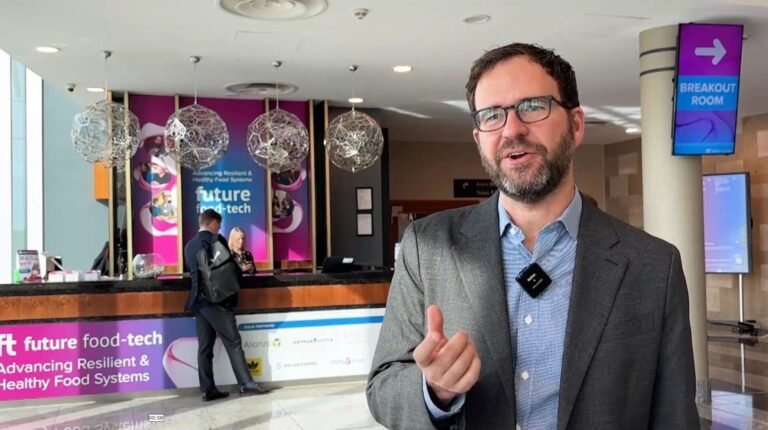Is fiber finally getting its day in the sun? Is RFK Jr’s anti-seed oil crusade filtering through to consumers? And have we reached peak protein?
We may see a falloff in the “faddish worship of protein,” predicted Mintel director, food & drink, Jenny Zegler at the third MISTA growth hack demo day in San Francisco last week. But broad interest in the macronutrient is likely to be sustained, despite the fact that most Americans do not need to consume more. “53% of consumers that are putting more effort into their diet are thinking more about protein.”
Fiber—where most Americans fall well short of recommendations—is also getting more attention, in part due to renewed interest in satiety and gut health driven by GLP-1 drugs, she said. “I think fiber is the new protein, plus it’s another area where consumers can really feel the benefits.”
Fellow panelist Lisa Curtis, founder of superfood brand Kuli Kuli, added: “Whole Foods Market is looking for products with more fiber. They tell us that they have a lot of greens and protein in our category but not enough fiber.”
While the Make America Healthy Again (MAHA) movement is stimulating more conversations about healthy eating, however, planetary health is not top of shoppers’ priority lists, she said: “Nobody goes to the store and thinks: What’s the most impactful thing I can buy?”
US consumers are trying to prioritize health, added Zegler at Mintel, “But 40% agree that due to the cost of living it’s harder to make healthier choices.”
GLP-1 support shots, happy biome protein puffs, ultrabiome gut shots…
Against this backdrop, startups need to collaborate with larger companies more than ever to bring new innovations to market, said MISTA head Scott May to 200+ delegates assembled in San Francisco last week. “The future of food will not be defined by one breakthrough but by how well we work together.”
A food innovation platform launched in late 2018, MISTA helps facilitate these collaborations by connecting startups with experts at Givaudan, Ingredion, AAK, SIG, JPG Resources, Buhler, and Danone to develop new food & beverage concepts in intense “growth hacks” over a period of several weeks.
The results of the latest hack (theme: healthy nutrition) were showcased on the demo day on October 8.
Concepts included:
‘Powerfuel sports beverage’ – featuring a highly soluble soy protein isolate from Alpine Bio, whey protein from Verley made via precision fermentation, and Superbrewed Food’s postbiotic protein;
‘GLP-1 support shot’ – containing The Every Co’s highly soluble egg glycoprotein made via precision fermentation, and vitamins from Infusd;
‘Powerstart breakfast burrito’ – featuring Sempera Organics’ nutrient-packed alt meat Mamu, Every’s ovalbumin egg protein made via precision fermentation, and Bettani Farms’ plant-based cheese.
The prototypes were developed with the help of AI-powered concept generator Mintel Spark, which generates mock-up images enabling users to instantly visualize product concepts and packaging ideas. Most attempted to pack in large amounts of highly digestible protein, different sources of fiber, and micronutrients from omega-3s to vitamins, without compromising on taste or texture.
Science projects or something more?
Given how easy it is for external innovation initiatives to turn into resource-sapping science projects that don’t go anywhere, startups and corporate partners need to define clear parameters and goals, said Ali Wing at sweet protein startup Oobli.
Rather than working from a generic starting point such as sugar reduction, for example, corporates should define specific pain points within a given space to help startups pitch solutions that are more likely to be on target, said Wing. “We shouldn’t really be pitching until we hear the specific requirements.”
Jeff Grogg at JPG Resources added: “You can only sell a solution if you know what the problem is.”
10 startups to watch from the 2025 MISTA growth hack:
Infusd has tech that makes insoluble and fat-soluble nutrients from vitamin E and DHA to natural colors and preservatives soluble in water using a proprietary physical processing method and natural stabilizers. The scalable tech keeps such ingredients “potent, fresh and shelf stable” for two years in liquid or powder form, even after pasteurization or UHT treatment, claims the firm.
BioLumen—the brainchild of Paolo Costa and pediatric endocrinologist Dr. Robert Lustig—deploys soluble and insoluble fibers to form microscopic fibrous “sponges” that expand in the stomach. Here, they sequester glucose, fructose, sucrose, and simple starches, rendering them unavailable for early absorption in the gut. The “colorless, odorless, tasteless, and texture-less” fibers can be consumed as a powdered supplement to consume with a meal, or formulated into foods from chocolate to ice cream, “mitigating the negative effects of ultra-processed foods,” says the firm.
Geltor deploys precision fermentation to produce collagen for multiple applications. Its ‘PrimaColl’ type 21 collagen has been shown in a recent human clinical trial to activate additional collagen production in the body and improve skin firmness, moisturization and elasticity and reduce wrinkle depth, says cofounder Alexander Lorestani.
Checkerspot makes high-value lipids via fermentation of microalgae including structuring fats, high-oleic frying oils, and functional lipids found in human breastmilk.
Alpine Bio – Best known as a molecular farming company that makes casein, lactoferrin and other animal proteins from genetically engineered soybeans, Alpine Bio has also developed tech to extract “insanely soluble” soy protein from non-GMO soybeans. (Disclosure: AgFunderNews’ parent company AgFunder is an investor in Alpine Bio).
Fotortec grows oyster mushrooms on food waste and processes them into a dehydrated powder that serves as a flavor enhancer to help food formulators reduce sodium in multiple applications.
Savor deploys a thermochemical approach to produce more sustainable, functional, and healthy alternatives to animal and tropical fats by taking a carbon source and hydrogen source, heating them up and oxidizing them to create fatty acids, the building blocks of fats and oils. To date, it has developed multiple prototypes that replicate the functional properties of milkfat, cocoa butter, lard, beef tallow and liquid vegetable oils.
Typcal São Paulo-based Typcal is seeking to blaze a trail in the Latin American market with mycoprotein which it claims grows more rapidly, on a broader range of feedstocks, than competitive fungi strains. Founded by former Red Bull executive Paulo Ibri and Dr. Eduardo Sydney, Typcal does not use any of the species employed by existing industry players such as Fusarium Venenatum (Quorn, ENOUGH Foods), Neurospora Crassa (Meati, The Better Meat Co), or Aspergillus Oryzae (Nosh.bio), says the firm, which is looking to build a b2b ingredients company supplying mycelium in a variety of formats to food manufacturers in applications from snacks to alt meat.
Optimized Foods uses koji (Aspergillus oryzae) to transform ag byproducts such as almond and pistachio hulls and coffee grounds into a range of ingredients from cocoa powder analogs to drop-in replacements for coconut fat flakes.
Sempera Organics makes a nutrient-packed alt meat product called “Mamu” that it produces by fermenting chickpeas with mushroom mycelium in a low-cost solid state zero-waste fermentation process in plastic bags rather than costly steel bioreactors. The product, which is “not meant to be a meat imitation,” can be used in sandwiches, pizza, meatballs and other center plate items, says the firm.
Superbrewed Food bacterial biomass has 85% protein by dry weight, a PDCAAS (protein digestibility) score of 0.91, which ranks higher than most plant proteins, and high levels of B vitamins including B12, plus minerals including iron and zinc. With a neutral taste and white color, pH and temperature stability, and emulsification properties, it is attracting interest in multiple categories, says the firm, which has struck deals with Döhler to manufacture its products at scale.
>>Music in video by AlexGrohl from Pixabay.
The post Collaborate or die: Hacking the next generation of healthy foods at MISTA appeared first on AgFunderNews.

